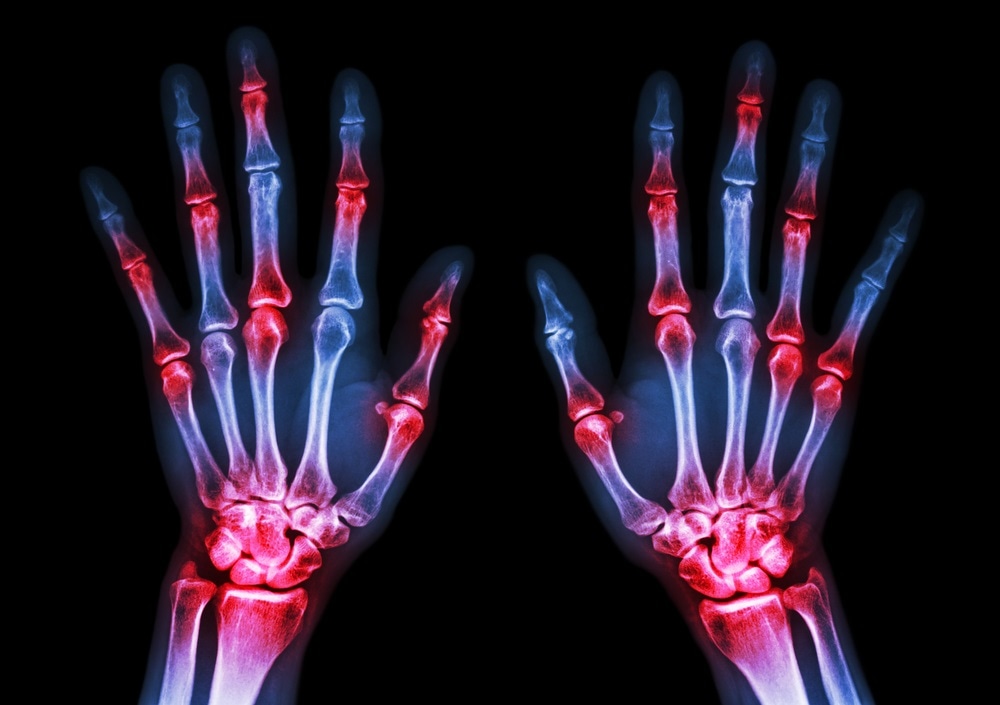Researchers at Osaka University in Japan have made an important discovery about a class of cells involved in rheumatoid arthritis that could pave the way for new treatments.
 Image Credit: Puwadol Jaturawutthichai / Shutterstock.com
Image Credit: Puwadol Jaturawutthichai / Shutterstock.com
The team has discovered a previously unknown type of osteoclast within affected joints affected that could one day provide a target for new therapies.
Arthritis is a common chronic condition
Arthritis refers to a group of more than 100 chronic diseases characterized by inflammation in the joints that can eventually lead to irreparable damage and debilitating pain and stiffness. Rheumatoid arthritis is an autoimmune form of the disease, where immune cells mistakenly target tissue that lines the joints, causing pain, swelling, and stiffness. Over time, this can damage the joints, cartilage, and surrounding bone.
There is currently no cure for rheumatoid arthritis, and treatment approaches are limited to drugs to alleviate symptoms, supportive treatments such as physiotherapy, and, in some cases, surgery to correct joint problems.
Since these approaches only relieve symptoms or at best delay disease progression, scientists are researching the condition in efforts to find potential new treatment targets.
Two main types of cell contribute to disease progression
In rheumatoid arthritis, two main types of cell contribute to the progression of the disease. Firstly, immune cells release inflammatory cytokines that aggravate tissue lining the joints. Secondly, specialized cells called osteoclasts secrete enzymes and acids that "dissolve" bone. In a healthy, non-disease state, osteoclasts remodel the bone, but in rheumatoid arthritis, their ability to breakdown bone is ramped up, which damages joints instead.
Treatments that target osteoclasts are limited
Currently, treatments for rheumatoid arthritis mainly target the immune cells that cause inflammation, while treatments that target osteoclasts are limited.
Therapies targeting osteoclasts are limited, largely because we do not know enough about the osteoclasts involved in RA. We were interested in understanding whether these cells are somehow different from the osteoclasts involved in normal physiological processes."
Masaru Ishii, study author
A new technique for isolating osteoclasts
Osteoclasts usually line the bone surface underneath layers of cartilage and tissue, which makes them difficult to isolate. To collect these cells, the researchers needed to find a way to extract them.
Using a mouse model of rheumatoid arthritis, Ishii, and colleagues developed a surgical technique that enabled them to extract osteoclasts from the animals'animals' femurs. They then studied how the cells differed from the osteoclasts found in healthy bone.
"We tracked precisely how arthritis-inducing osteoclasts develop from their undifferentiated precursor cells," says lead author Tetsuo Hasegawa. "While normal osteoclasts are derived from stem cells in the bone marrow, we found that osteoclasts involved in RA come from blood-borne precursors. The circulating precursors enter the joint and differentiate into a unique sub-type of osteoclasts, which are larger and have distinct markers that are not seen in other osteoclasts."
The new sub-type of osteoclasts had properties that could be manipulated
The newly found cells, which the team has dubbed "AtoMs" (Arthritis-associated osteoclastogenic Macrophages), possess properties that could be manipulated in approaches to developing new treatments.
For example, the AtoMs have an abundance of the protein FoxM1, which is known to make cells invade tissue. The team hypothesized that eliminating this protein may reduce its arthritis-inducing ability.
As reported in the journal Nature Immunology, the researchers confirmed that this was, in fact, the case. When they genetically or chemically disabled FoxM1 in AtoMs, the destruction of the bone was reduced in the animals' joints.
"Our findings suggest that osteoclasts involved in RA have distinct properties that make them amenable to therapeutic targeting," says Ishii. "While there is still a lot to learn about this class of cells, we believe the discovery could open the door to new avenues of treatment."
Source:
Researchers split the 'AtoM' in search of a treatment for rheumatoid arthritis. Eurekalert. Available at: https://www.eurekalert.org/emb_releases/2019-11/ou-rst111219.php